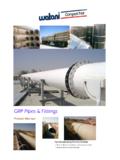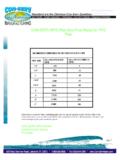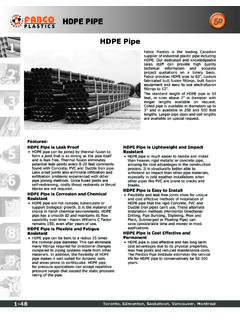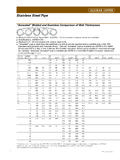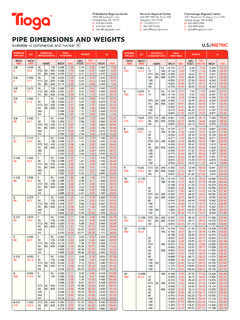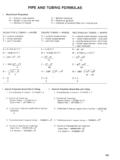Transcription of PIPESIZE spreadsheet template sizing. - Pipe sizing …
1 UINS PS 02 April 2013 1 PIPESIZE spreadsheet template for pipe sizing . Copyright 2013 by Stephen Hall, PE PIPESIZE is an Excel spreadsheet template . It sizes pipes for liquid or gas flow. PIPESIZE is extensively tested; I created the first version in 1989 and have continually enhanced it since. The 2013 version ( ) adds a much improved calculation algorithm for heat loss/gain estimates, and a new Line List feature. The template consists of several worksheets. Most of your data input is on the Data Input worksheet; the others are used for assembling reports and supporting data. Cells requiring User Input are displayed with RED text; other cells are in BLACK. Figure 1: Most data input is done on the Data Input worksheet PIPESIZE 2 Table of Contents Quick Start .. 3 System Requirements .. 4 Initial Setup and 5 Data Entry Worksheet .. 8 Quick Results .. 12 Datasheet .. 13 Errors and Warnings .. 14 Pressure Drop Calculations .. 15 Heat Loss/Gain Calculations .. 18 Insulation Worksheet.
2 23 Properties Worksheet .. 24 Line List Worksheet .. 29 LIQFLOW Worksheet .. 30 OPTLIQ Worksheet .. 31 Equivalent Length Worksheet .. 32 Velocities Worksheet .. 34 PIPESIZE 3 Quick Start Perform your first pressure drop calculation by following these steps: 1. Ensure that Macros are enabled 2. Navigate to the Data Input worksheet 3. Cell C17: Choose preferred system of units, English or SI (radio buttons) 4. Cell G32: Choose Liquid or Gas (radio buttons) 5. Cell F31: Enter name of the fluid, or choose one from the pulldown list at H31 6. Cell F33: Enter the flowrate (be sure to use the units that are indicated) 7. Cell F36: If this is a gas calculation, enter the pressure 8. Take note of the messages at Cells E32, G37, G38, and G39. Enter data if it says Entry Required (it means that the fluid name entered in Cell 31 is missing from the Properties Table, see page 24) 9. Cell D43: If you are calculating for a known pipe diameter, select the Specific Diameter (radio button).
3 Otherwise, select Economic 10. Cell G47: Enter the approximate equivalent length of the pipe segment you are calculating. If you don t know the equivalent length, enter a value that is times the actual length of the pipe . Read results in the table in columns K:N. Notice that results for three pipe sizes are displayed. The specified size (or size determined by PIPESIZE ) is in the middle, at Rows 35 to 41. It is flanked by the next smaller and next larger sizes. There are many additional variables that you can enter; they are explained in this manual. However, for the most part, the inputs are self explanatory. PIPESIZE 4 System Requirements Personal computer running Microsoft Excel with Visual Basic for Applications (VBA). This requirement means that Open Office and other programs capable of opening and editing basic Excel worksheets will not work VBA is required. Excel 97 on the Mac lacks VBA and is therefore incompatible, however Office 2010 on the Mac is compatible Excel must be configured to allow macros to run.
4 This can be done through Security settings, or by enabling macros each time PIPESIZE is opened PIPESIZE 5 Initial Setup and Orientation When you first open PIPESIZE you should see the Data Input screen. If not, select the leftmost tab at the bottom of the Excel window. We recommend that you start by exploring a bit. Entries that appear in RED are valid cells for data entry. The BLACK cells contain results from intermediate or final calculations. Generally, only the RED cells are unlocked. You quickly navigate among them by using the TAB key. Although the worksheets are Protected, this is only done to help avoid inadvertent changes to cells that contain formulas. There are no passwords and the entire workbook is Open Source. PIPESIZE is shipped configured for printing on US letter size paper. If you use A4 paper, please go to each sheet in turn. Go to Page Then change paper to A4 and left/right margins to cm. The pages should then print properly. Number and date formats vary around the world.
5 While numeric values are formatted according to global settings in Excel, PIPESIZE also makes use of text formulas that are formatted according to a string within the formula. This string is unaffected by Excel s global formatting preferences, having a syntax such as: =TEXT(numeric value, ). To get around this problem, a table of formats is provided on the Pipes worksheet at Row 166. If you use anything other than dd mmm yyyy for dates, or #,## for numbers, edit the formats in the table. The next thing to do is review the Pipes worksheet. If your company or workgroup has standard pipe specifications you may want to edit the Pipes sheet to accurately portray your specs. If you don't have specifications, consider creating codes for commonly used types, such as "CS" (for carbon steel) and "SS" (stainless steel). The pipe specification codes are entered in the table at the top of the Pipes worksheet. Codes must be entered in alphabetical order (you can insert new rows if you like).
6 Then, follow the column headings to enter temperature and pressure limits, roughness value, cost data, and related dimensional table number. Although the entries in this table are in customary US units, the PIPESIZE reports use either US or SI units for reporting (in accordance with your selection). Each column entry is explained below. Cost FactorsSpec CodeDescriptionMin Temp Max Temp Max PressRoughness PurchaseRatioExponentSizeEmissivity Conductivitydeg Fdeg Fpsigft$/ft (1 inch)FittingsTableW/m-KA150 lb Carbon $ lb Carbon $ lb Carbon $ SS $ $ SS Sanitary $ SS Zephyrweld $ $ Figure 2: pipe Specifications on the Pipes worksheet PIPESIZE 6 Spec Code may be any alphanumeric string. It is usually a designation used on P&IDs and other documents that references a complete pipe specification. The Spec Codes must be sorted alphabetically. Rows may be inserted into the table if more codes are needed. Description is plain language to describe the pipe specification.
7 It is used on the printed data sheet. Temperature limits are entered in degrees Fahrenheit. These are the minimum and maximum temperatures allowed for the pipe class, often determined by components in your piping system such as gaskets and valves. If the fluid temperature is outside the range defined by these limits a warning message is printed on the data sheet. Pressure limit is the maximum gage pressure permitted (psig) for the pipe code. The only thing that temperature and pressure limits affects within PIPESIZE is a Warning in the event that the limits are violated. pipe Roughness is entered in units of feet. See the Roughness worksheet for a list of recommendations. Roughness for new pipe is often listed in handbooks, but consider whether it's more appropriate to use a value for used pipe one that is more representative of how your system will operate after a couple of years of operation. Cost Factors are entered for a) initial capital cost of 1 foot of 1 inch pipe , installed, b) a ratio relating the cost of fittings and valves to the cost of pipe , and c) an exponent used to convert to other sizes.
8 This is in accordance with the Peters and Timmerhaus method. We suggest you use values like the ones given until you gain experience with the OPTSIZE worksheet results. Size Table is a pointer to one of the many pipe dimension tables appearing below. Each dimension table contains five columns of data, which in turn can be formulas to look up wall thicknesses for a given schedule, etc. Use the pipe Specification Lookup Tables at Row 44 to control the minimum and maximum allowed diameters in your pipe specifications. Also use them to eliminate unwanted sizes such as 1 1/4" or 5". Study the tables given with PIPESIZE , and either edit an existing one or create new tables in columns to the right of the existing ones. 8910 Stainless Steel PipeTeflon-Lined SteelStainless Steel Tubing ( TableRed values are variablesBlack values are formulas or constantsColumn name is user-defined The pipe Specification Lookup Tables can reference any of the several dimension tables found in the PIPES worksheet.)
9 Study the pipe Table formulas to see how this is done. Here's an example dimension table, used to lookup the dimensions of copper pipe : PIPESIZE 7 pipe Size Lookup TableCopper a nd Re d Brass PipeWall ThicknessNominal Emissivity is the radiation constant for a bare pipe . Suggested values are given in a table beginning at Row 138 on the Pipes worksheet; emissivity must be between 0 and 1. Conductivity is the thermal conductivity of the pipe material, W/m K. The heat loss/gain calculation does not include a provision for lined pipe , so use an estimate for combined conductivity, which should be greater than the material (usually the lining) with the smaller value. For example, the conductivity of polypropylene is W/m K. For polypropylene lined pipe , where the thickness of the lining is greater than the thickness of the steel, use a value of or as an estimate for the combined lined pipe system. PIPESIZE 8 Data Entry Worksheet The data entry worksheet consists of several parts, discussed in turn below.
10 Remember that RED cells are unlocked and available for entry. If you need to change the value of a locked cell, unprotect the worksheet from the Tools menu. There is no password. Use the TAB key to quickly navigate from one entry field to the next. Project Data appears on the headers of each of the standard reports. Notice that the Date field is automatically filled with today's date. This can be changed by unprotecting the worksheet, as mentioned above. The formula in the date field is: =TEXT(TODAY(),"dd mmm yyyy") The Units radio buttons control whether input and output are shown in English ( , customary US) or SI units. DATA INPUTP roje ct Da taPrepared byS. IDLine Number:HTF-151-0136 EnglishSI General Pipeline Data refers to the piping system and materials. Service is a descriptive tag for the purpose of the pipeline. Any text is accepted. The pulldown box (contains "A" in the screen shot below) shows all of the pipe codes contained in the PIPES worksheet. The description of the selected code appears to the right.

